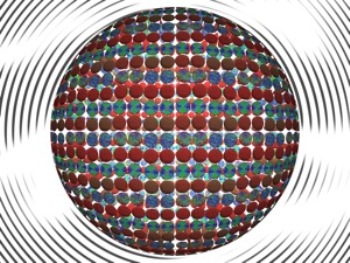A team of international scientists led by Juan J. de Pablo, a Professor of Chemical and Biological Engineering at the University of Wisconsin-Madison, has discovered that the manipulation of liquid crystals at the nanoscale can make the molecules they interact to self-assemble, thus paving the way to develop innovative materials with novel properties.
 A computational model shows nanospheres of liquid crystal materials. The different patterns represent the self organization of surfactants, the molecules the liquid crystals interact with at their surface interface. (Image: Juan de Pablo.)
A computational model shows nanospheres of liquid crystal materials. The different patterns represent the self organization of surfactants, the molecules the liquid crystals interact with at their surface interface. (Image: Juan de Pablo.)
The results of the computer simulation study have been reported in the Nature journal. The study reveals the possibility of spontaneously forming new nanoscale morphologies using liquid crystals. The computational study simulated the characteristics of numerous rod-shaped liquid crystal molecules confined inside nano-sized liquid droplets. The study demonstrated that these liquid crystal molecules are capable of self-assembling when the droplets are cooled.
de Pablo explained that the cooling process forms a liquid crystal phase because the liquid droplets become ordered upon cooling. What surprised the team was the behavior of the liquid crystallinity inside the droplets that stimulated the self-organization of water and other molecules present at the droplets’ interface, called surfactants, to form nanodomains.
This result shows that the interface molecules assume a homogeneous distribution when a liquid crystal is absent. However, the presence of a liquid crystal makes them to create an ordered nanostructure. de Pablo informed that the study results offer the possibility to create new structures and materials through the formation of these ordered nanophases by manipulating them either through surfactant concentration or droplet size.
For instance, surfactants bonded to DNA molecules can be attached to liquid crystal droplets, which can then be organized through DNA hybridization, opening up the possibility to detect viruses, biological molecules and toxins using liquid crystals. The arrangement of the liquid crystals and the surfactants inside the droplet gets changed when a protein or virus is attached to the droplet, thus generating an optical signal, which is useful in biology research settings, health care and biosecurity.